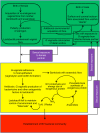Pathogenesis of Bacterial Vaginosis: Discussion of Current Hypotheses
- PMID: 27449868
- PMCID: PMC4957507
- DOI: 10.1093/infdis/jiw121
Pathogenesis of Bacterial Vaginosis: Discussion of Current Hypotheses
Abstract
In April 2015, the Division of Microbiology and Infectious Diseases of the National Institute of Allergy and Infectious Diseases hosted an experts technical consultation on bacterial vaginosis (BV), where data regarding controversies over the pathogenesis of BV were discussed. The discussion on the epidemiology and pathogenesis of BV is presented here, and several hypotheses on its pathogenesis are critiqued. Rigorous hypothesis-driven studies are needed to ultimately determine the cause of BV. This information is vital for the prevention and control of this important infection and its adverse public health consequences.
Keywords: Gardnerella; bacterial vaginosis; vaginal flora.
© The Author 2016. Published by Oxford University Press for the Infectious Diseases Society of America. All rights reserved. For permissions, e-mail journals.permissions@oup.com.
Figures

References
-
- Eschenbach DA. Bacterial vaginosis and anaerobes in obstetric-gynecologic infection. Clin Infect Dis 1993; 16(suppl 4):S282–7. - PubMed
-
- Hillier SL, Nugent RP, Eschenbach DA et al. . Vaginal Infections and Prematurity Study Group. Association between bacterial vaginosis and preterm delivery of a low-birth-weight infant. N Engl J Med 1995; 333:1737–42. - PubMed
-
- Hillier S. The vaginal microbiol ecosystem and resistance to HIV. AIDS 1998; 14:17–21. - PubMed
Publication types
MeSH terms
Grants and funding
LinkOut - more resources
Full Text Sources
Other Literature Sources
Miscellaneous

